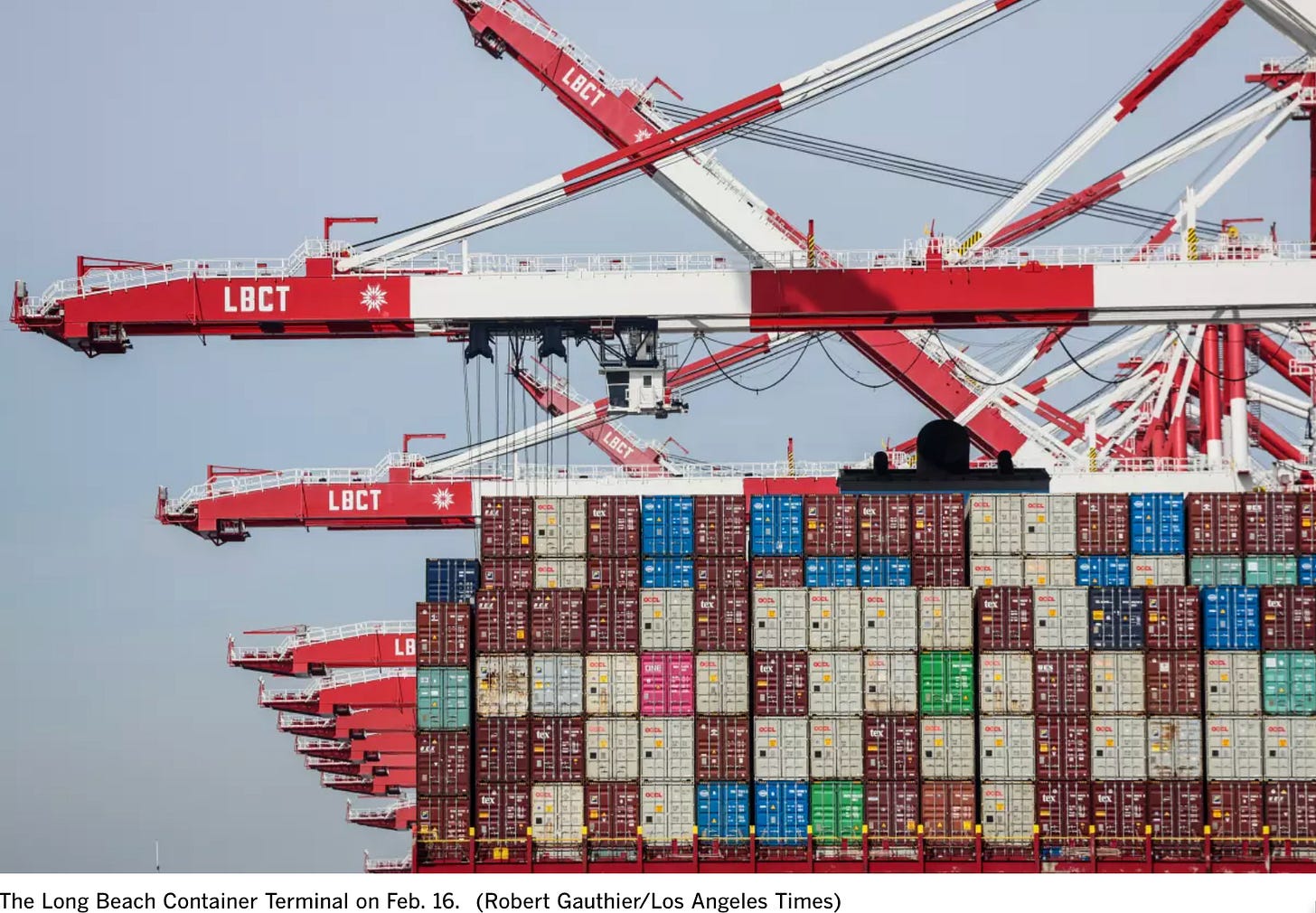8% of the Flow of US Real GDP Is Likely to Vanish in the Next Three Months: The Ports Will Be Empty, & then the Shelves
Launching a strategy-less trade war has consequences: f*** around & find out what happens when you make trade policy as a side-effect of performance art: China loses $4 billion a week that it has to cushion and cover, and the US loses 10 times that. You cannot retail, ship, inspire, or get paid for designing goods that do not arrive—yet the Trump administration pretends that the 86% of the economy that is not imports will be just fine this summer…
Gene Seroka of the Port of Los Angeles predicts a 35% drop in shipments through Long Beach, as Chinese exports to the U.S. grind to a halt. This isn’t happening as the result of a negotiation move—there are no negotiations, no plan, and no economic policy beyond some slogan “fair trade” slogans.
The Trump administration has isolated itself not only from China, but from willing trade partners like Japan, Mexico, and Korea, all of which played ball with Trump I but get nothing in return, and now find themselves not in any “green box” at all. The likely result? Stagflation. China, with its centralized coordination, is maneuvering to blunt the damage and spread out responsibility for its $4 billion a week of likely economic losses that have already started. The U.S., led by a chaos monkey, is barreling toward a breakdown in consumer access, manufacturing continuity, and economic growth—with no relief on the horizon, and no plan for cushioning the knock-on consequences of losses likely to be ten times as much, or twenty times as much once one factors in the wedge between exchange-value and true economic use-value.
This is about value chains: the intricate layering of value-added activities by which a $100 shoe contains $20 in resource and manufacturing costs and delivers an extra $80 in use value in logistics, design, and consumer resonance. If the physical good doesn’t show up, all the value built around it disappears. The Trump administration claims deregulation and tax policy will boost the 86% of the economy that are not imports, make up for this, and claims not to understand why tariffs rather than tax policy or deregulation dominate the headlines. But the numbers—and soon the empty racks—will say otherwise.
Economic bells, tolling:
Laurence Darmiento: Traffic at the Port of Los Angeles set to plunge amid tariffs <https://www.latimes.com/business/story/2025-04-24/traffic-at-the-port-of-los-angeles-set-to-plunge-amid-tariffs-disruption>: ‘Imports at the Port of Los Angeles are expected to plunge in the next two weeks, even as negotiations over the final tariffs that China and other countries must pay are still being negotiated by President Trump. That was the sobering message that port Executive Director Gene Seroka had Thursday for the Los Angeles Board of Harbor Commissioners during an update on port activity. “It’s my prediction that in two weeks’ time, arrivals will drop by 35% as essentially all shipments out of China for major retailers and manufacturers have ceased, and cargo coming out of Southeast Asia locations is much softer than normal,” Seroka told the board…
BUT THERE ARE NO NEGOTIATIONS BEING NEGOTIATED WITH RESPECT TO THE TRUMP TARIFFS ON CHINA. TO SAY THAT “NEGOTIATIONS OVER THE FINAL TARIFFS… ARE STILL BEING NEGOTIATED BY PRESIDENT TRUMP” IS TO FALSIFY WHAT IS GOING ON.
I mean, there are not even ongoing negotiations with Japan, which very much wants to negotiate.
And it seems as though Sheinbaum and Carney have also given up on talking to Trump, expecting a rather thorough reset to hit the Trump administration in the next couple of months.
Here is my guess as to what the most likely scenario is:
Back when my wife’s and my older kid was running high-school cross-country, we would get him Nikes to run in.
The exchange-value of the Nikes we got him was divided, roughly:
10 bucks for the raw materials.
10 bucks for the production labor
20 bucks for Nike for design, organization, return on capital, and market-power profits.
10 bucks would be for the symbolic links created between the shoes on th one hand and athletic achievement kinds of things—“just do it”, the mental part of the game that made Michael Jordan an extraordinarily rich man in his day.
15 bucks for transportation—1 buck from the Pearl River Delta to the Port of Oakland, and then 14 more about that to get the shoes to where we could see them and buy them and carry them home.
35 bucks for getting him not just a shoe but the right shoe, in the right size, fitted to him by a half-crazed marathon working at an athletic shoe store in Walnut Creek, California.
And over and above that 100 bucks in exchange value:
Figure another 100 bucks in use-value margin for getting him a really good shoe for the task rather than just running in converse sneakers.
So 200 bucks in total economic value created for us from the athletic-shoe trans-Pacific value chain in the globalized value-chain economy late in the decade of the 2000s. And 100 bucks recorded in the National Income and Product Accounts—$100 in final sales in the U.S., minus $20 in imports, with the balancing $20 in exports counted in GDP over in Asia.
Of this, $10 were raw materials from east and southeast Asia, and $10 were production labor costs in the Pearl River Delta.

